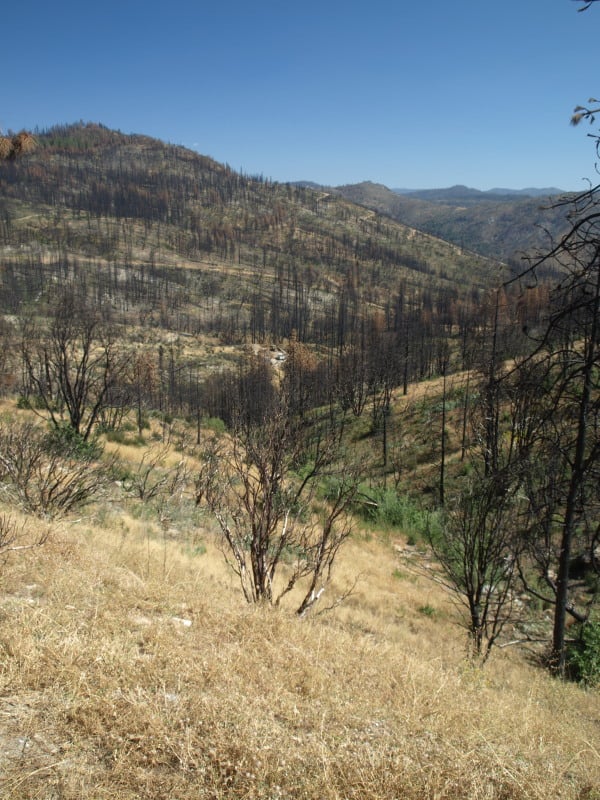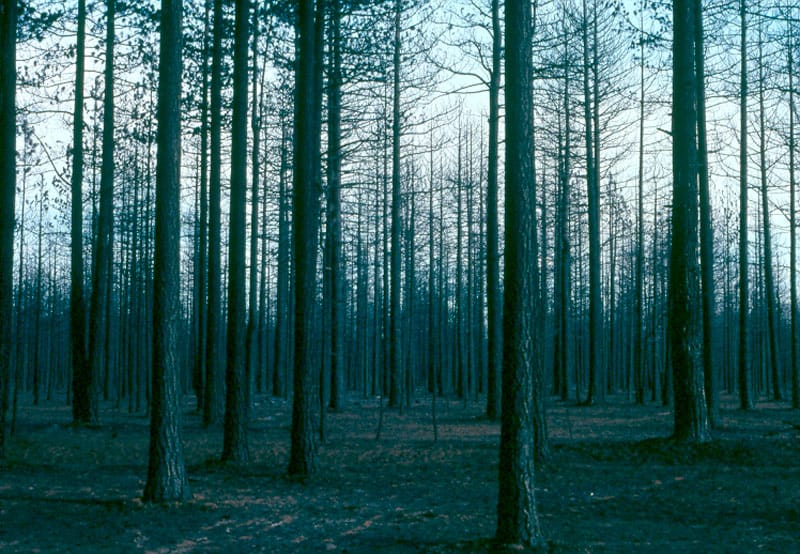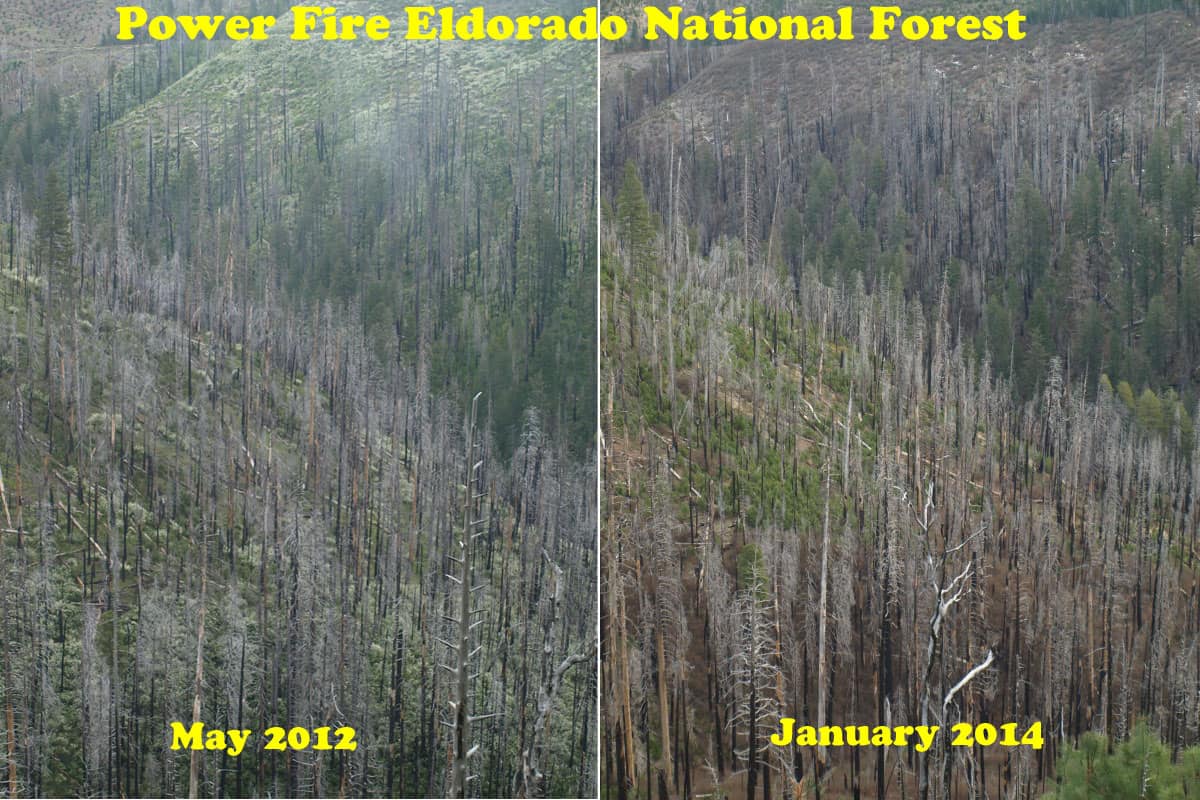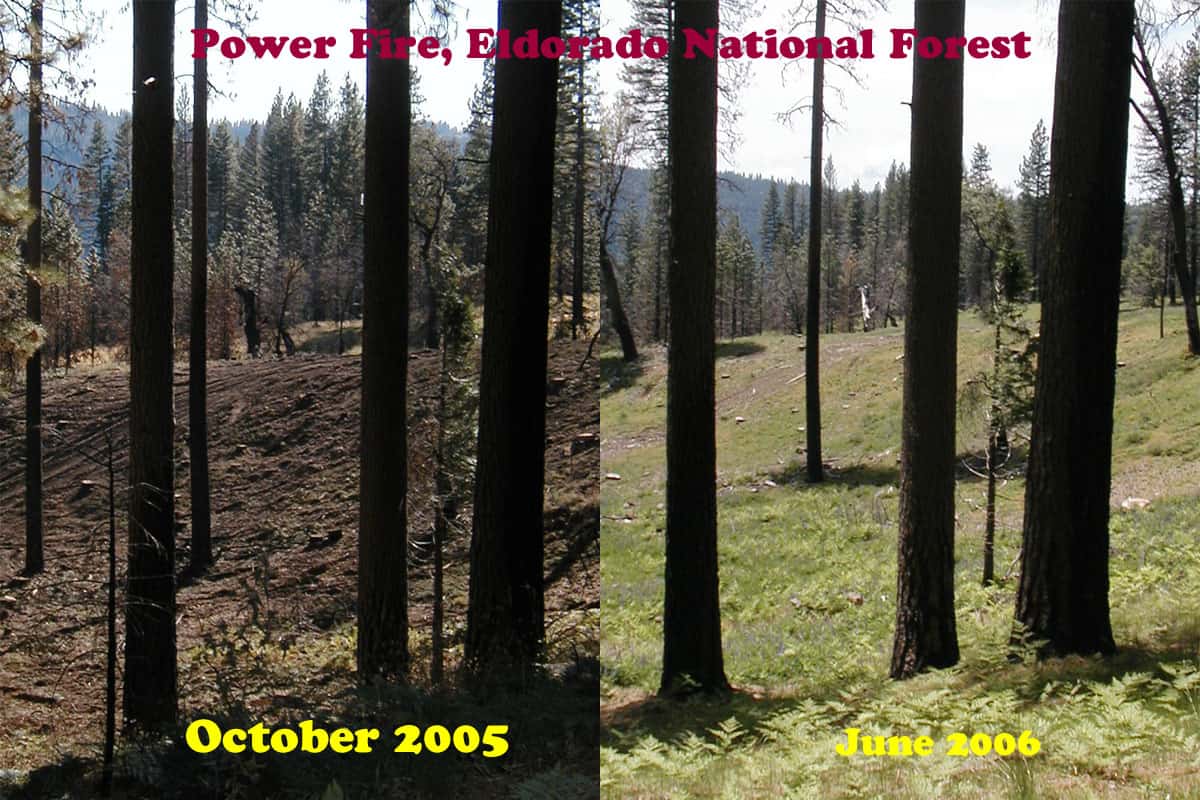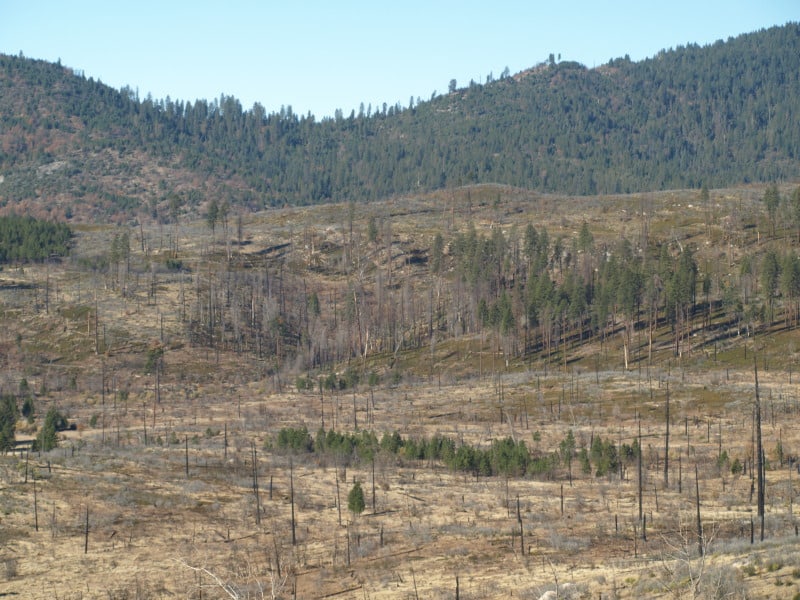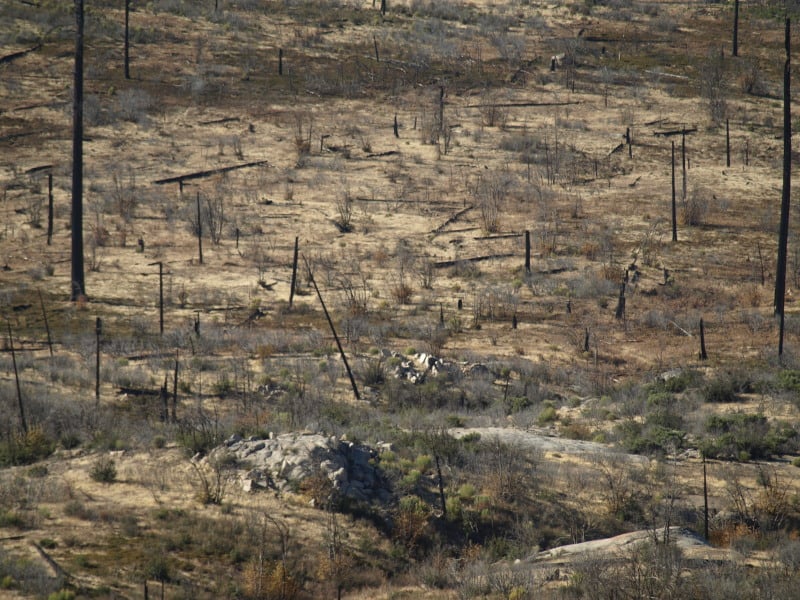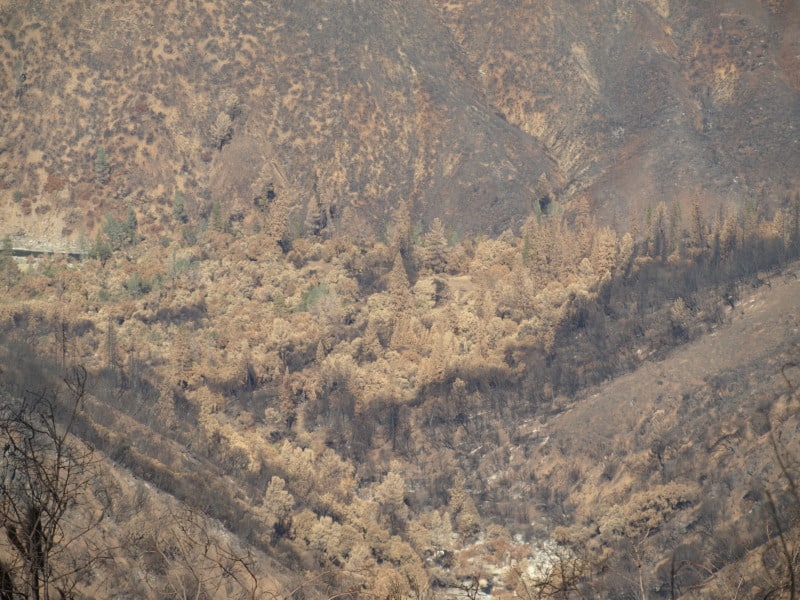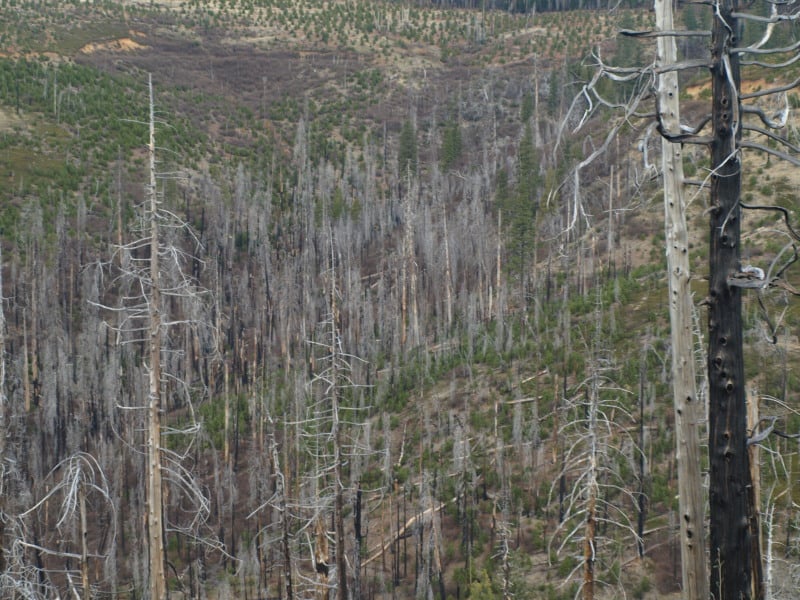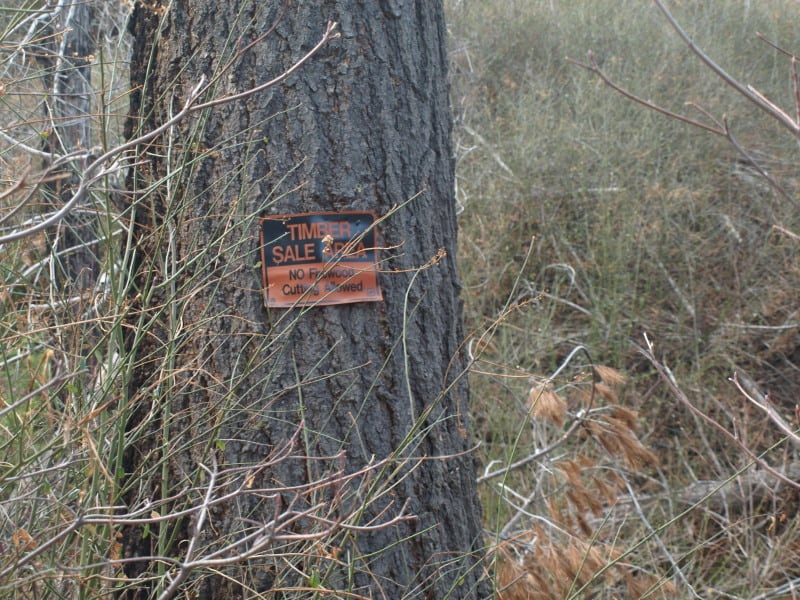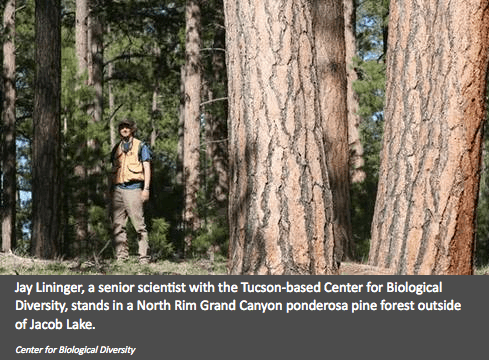Here is a view of the Granite Creek watershed, and a peek at the Tuolumne River canyon, too. The Rim Fire burned all the way to those most-distant ridgetops. For scale, you can see a vehicle in the middle of the picture. That road is the Cherry Oil Road, which connects Cherry Lake with Highway 120. That greenish tint is the vast growth of bearclover, easily reclaiming their “territory”. Bearclover is one of the reasons why clearcutting has been banned in Sierra Nevada National Forests since 1993.
Restoration
Throwback Thursday Hits NCFP!
After the “Siege of 1987”, and 43 wildfires on the Hat Creek Ranger District, in three days, the Lost Fire burned up this forest up on the Hat Creek Rim. Even without terrain effects, this fire raged through the forest incinerating everything in its path. There is an eerie beauty in this picture, reminiscent of an Ansel Adams monochrome image.
Today, those forests are growing back, after a big reforestation program, and it appears, a subsequent thinning. Here is a Google Maps view of that area today.
https://www.google.com/maps/@40.8027893,-121.4002792,862m/data=!3m1!1e3?hl=en
Already this summer, there has been 3 large wildfires on this Ranger District. It is mostly a dry “eastside pine” forest, requiring trees to be thinned and crowns separated. It appears that the Forest Service is finally seeing that early thinning is key to restoring forests. In the past, it always appeared that they were “gambling” on waiting for the trees to get bigger (and more profitable), before managing their plantations.
Repeat Photography: Part Deux
It’s kind of a challenge to assemble pictures shot in different years, from different spots, and from different cameras. This is an excellent way to view and monitor trends, showing the public what happens over time to our National Forests. Sometimes, you have to look hard to see the differences. In any future repeat photography projects, I will be using very high resolution, to be able to zoom in really far.
One of the reasons why you don’t see much “recovery” is that the Eldorado National Forest has finally completed their EIS for using herbicides in selected spots, almost 10 years since the fire burned. This is part of the East Bay’s water supply. Sierra Pacific replanted their ground in less than 2 years. So, the blackbacked woodpeckers should be long gone, as their preferred habitat only lasts for an average of 6 years. As these snags fall over, the risk of intense soil damages from re-burn rises dramatically. Somewhere, I have some earlier pictures of this area which may, or may not line up well with this angle. I’ll keep searching through my files to find more views to practice with.
Repeat Photography and Salvage Logging Recovery
My first attempt at assembling pictures, showing how quickly salvage impacts can “heal”. Here is the current aerial view of this specific area.
https://www.google.com/maps/@38.4831284,-120.3639833,223m/data=!3m1!1e3?hl=en
Here is a view of a re-burn that has already occurred, in the same area. Notice the lack of significant mortality, due to having salvaged the area, reducing the fuels of the inevitable future fires.
https://www.google.com/maps/@38.4770266,-120.3464336,892m/data=!3m1!1e3?hl=en
One of the biggest “purpose and needs” in the Sierra Nevada is fuels reduction after a wildfire. Otherwise, re-burns, like the Rim Fire will dominate the landscapes for an indefinite amount of decades.
Yosemite’s Re-re-Burn
The El Portal Fire, burning in Yosemite National Park and the Stanislaus National Forest, has taken a familiar path. Starting very close to where the 1989 A-Rock Fire began, it easily burned up the steep canyon slopes, out of reach of firefighters. Not too many people are making the connection between this set of fires, the A-Rock, the Big Meadow and now the El Portal Fire, and the Rim Fire re-burn (and its prior fires).
Below is what the Foresta area looked like in November. Did those green trees survive this fire? We can’t be sure until the bark beetles have decided their fate, over the next few years. The forested slopes in the background were salvaged under the original A-Rock salvage project, and you can see that it looks about as good as a burned and salvaged landscape can be. Parts of that ridge top have had 13 fires in the last 100 years. The northern third of the fire burned into areas partially burned in the Big Meadow Fire. Up there, fuels are much heavier, and some of it had made it to the ground.
Edit: The fire’s boundary has slopped over that far ridge top but, there is less fuel on that dry west-facing slope, and the fire is just smoldering at the north end. Now, with more re-burn! It will be interesting to see how intense it was, burning through the salvaged part of the A-Rock Fire.
So, how long do you think it will take to turn this former pristine old growth stand back into a viable forest? Remember, this was a prime summer site for Indians, who expended a lot of time and energy to manage the ladder fuels. You can also go see the bigger picture here, at https://www.google.com/maps/@37.7045826,-119.7624808,7211m/data=!3m1!1e3?hl=en The northern end is very close to Crane Flat. Suppression costs have topped 8 million dollars. Also, how long will it take before blackbacked woodpeckers are on THIS piece of land? We need to learn from this example, or be doomed to repeat this moonscape.
Talkfest about “Large Wildland Fires”
This conference is going on this week in Missoula. With this many events and speakers I would like to think that someone would talk about the legal and administrative framework for making decisions about fire prevention and management on national forest lands. That would be the National Forest Management Act and land management plans. Specifically the law’s requirement that “resource plans” (fire plans) and projects (fuel treatments and fire suppression actions) “shall be consistent with the land management plans.” The new planning rule also requires that development of plan components consider “wildland fire and opportunities to restore fire adapted ecosystems.” Someone should maybe be thinking and talking about how revised forest plans should plan for fire (where we want what on a national forest).
Does anyone in the fire profession care about this? Apparently the ‘counter-culture’ does – Professor Richard Hutto will talk about “It’s Time to Integrate the Ecological Benefits and Necessity of Severe Fire in National Fire and Forest Management Plans.” There’s also one (1) presentation by Forest Service fire staff that sounds like it could talk about the decision-making process on national forests: “Integrating Fuel Treatments in Land Management Planning and Wildfire Incident Response.” I hope that someone who knows something about the Forest Service planning process has been involved.
Forest Service ESA/NFMA success story
The West Virginia northern flying squirrel was removed from the endangered species list a few years ago, apparently mostly the result an effort to restore red spruce trees in the Monongahela National Forest. This story doesn’t mention the forest plan, but says that 100,000 acres are being “managed primarily for red spruce.” Here is what the plan says:
“Management Prescription 4.1 emphasizes the active and passive restoration of spruce and spruce-hardwood communities and the recovery of species of concern found in these communities, a mix of forest products, and management of hardwood communities where spruce is not present or represents only a negligible component of a stand, and research or administrative studies on spruce restoration. On lands determined to be suitable habitat for the West Virginia northern flying squirrel, vegetation management initially would be limited to research or administrative studies to determine effective habitat enhancement techniques for the squirrel. After such studies have demonstrated effective techniques, vegetation management to enhance habitat for the squirrel or other TEP species could occur on a larger scale (see FW standard TE61).”
“Objective WF11 – Maintain at least 20,000 acres of mid-late and late successional (>80 years old) spruce forest to provide optimum habitat for West Virginia northern flying squirrel, a Management Indicator Species. The long-term objective is to increase mid-late and late successional spruce forest to at least 40,000 acres.”
According to the de-listing rule: “Implementation of the amended Appendix A guidelines by the Monongahela National Forest (MNF) effectively abated the main threat to the squirrel (i.e., habitat loss from timber management) throughout the majority of its range, by eliminating adverse impacts on all suitable habitat on the MNF without having to prove WVNFS presence.”
What’s not to like about this as an example of how public land laws can work the way they were intended? If there’s any easterners more familiar with the back-story, maybe they could share it.
The current interest is related to coverage of the flying squirrel in the April/May issue of The Nature Conservancy Magazine. Here’s more on red spruce.
Balanced Post-fire Treatments in the Rim Fire
I ran across this excellent article from Eric Holst, Senior Director of the Environmental Defense Fund’s “working lands program”.
Here’s the link: https://www.edf.org/blog/2014/02/18/after-rim-fire-surprising-role-salvage-logging
This picture is a view looking down into the Tuolumne River Canyon, from the “Rim of the World” overlook. Down there is where the fire started. I’d bet the spin on this wildfire would be VERY different if it was ignited by lightning.
Holst is showing some excellent judgement in looking at the bigger picture of the realities of the Rim Fire, seeing that “letting nature take its course” isn’t the way to go on every burned acre.
The Forest Service recently proposed to conduct salvage logging – removal of dead trees – on about 30,000 of the 98,049 acres of high intensity burned area and remove hazard trees along 148 miles of high use road in the burn perimeter. While it may seem counterintuitive for a conservationist to do so, I support this effort. In the high intensity areas, the Rim Fire burned so hot that it not only killed every tree but the top inch or two of soil with critical soil microfauna, and seed stocks were also sterilized. Fire of this intensity has been relatively rare in the moist middle elevations on western slopes of the Sierra Nevada and the native forests are not adapted to bounce back from this type of fire.
There are also some “interesting” comments, and a hint of “eco-bickering”. In those comments is also a return of the “Chapparalian”, using his actual name (instead of one of his many pseudonyms and even fake names). There are also some other interesting names commenting about these issues. John Buckley, a local leader of an environmental group comments with an open mind and a dose of reality. Others continue to spout the misguided idea that leaving the Rim Fire alone is the only way to go. Some commenters talked about the reality that we have plenty of BBW habitat, protected within the National Park. One reality not covered is that re-burns cause extensive damage that is very difficult to recover from, especially in areas left to “recover on their own”.
I still see that post-fire management is essential to getting big trees back on the land. We already have site-specific evidence that forests didn’t return when post-fire management was excluded, 40 years ago. We ended up with old growth brushfields, and a few stunted trees. Those old brushfields burned at moderate intensity. We have a big variety of landscapes, with differing burn intensities and site-specific conditions. This partial comment is spot-on, regarding these facts
It is interesting to see how many comments Eric’s post attracted from authors who are vehement that absolutely nothing except ‘let nature takes its course’ on National Forest lands. Since we have 100,000 acres of National Park land for that experiment, it would be more interesting to apply some other options on the National Forest lands. In the climate change debate, we continue to witness the rapid expansion of vocal people so sure of their own story that they refuse to even consider the possibility that it is worth learning more about the changing earth. Hopefully, this fate will not befall the response to the Rim Fire.
It seems pretty clear to me that a few open-minded people from both sides are seeing the realities of the Rim Fire, and its future.
Power Fire 2014
We’ve seen pictures of the Power Fire, on the Eldorado National Forest, before. I worked on salvage sales until Chad Hanson won in the Ninth Circuit Court, with issues about the black-backed woodpecker. The court decided that the issue needed more analysis, as well as deciding that the Forest Service’s brand new mortality guidelines were “confusing”. From these pictures, it is very clear to see that those mortality guidelines were way more conservative than they maybe should have been.
As you can see, in this finished unit(s), there were ample snags available for birds to use, despite multiple cuttings, due to the increased bark beetle activity, during the logging. No one can say that they didn’t leave enough snags, (other than the Appeals Court). These pictures are very recent, shot last month.
This picture amused me, as I put this sign up back in 2005. Plastic signs last much longer than the old cardboard ones.
Here is another view of the area, chock full of snags, well beyond what the salvage plans asked for, to devote to woodpeckers and other organisms that use snags. People like Chad Hanson want more high-intensity wildfires, and more dead old growth. It is no wonder that the Sierra Club decided he was too radical, even for them.
Edit: Here is the link to a previous posting from almost 2 years ago, with pictures. https://forestpolicypub.com/2012/05/28/the-power-fire-six-years-later/
“Wild Buck” Timber Sale Undercuts Forest Restoration
http://www.azcentral.com/opinions/articles/20140202old-growth-logging-undercuts-forest-restoration.html
The old “yellow-belly” ponderosa pines anchoring the majestic forests of the Grand Canyon’s North Rim grew up long before European settlement. Precious few remain.
More than 1,000 of them will be lost forever in the “Wild Buck” timber sale later this year, undercutting U.S. Forest Service claims that it is restoring this fire-adapted forest ecosystem.
Data obtained under the Freedom of Information Act shows that 38 percent of timber volume in the Wild Buck sale will come from logging 1,174 trees larger than 24-inches diameter. Field surveys by the Center for Biological Diversity revealed that many of those giant trees stood tall when the United States declared independence well over 200 years ago.
Old-growth pines are rare as a result of past logging. Their towering canopies and thick bark make them naturally fire resistant.
Hundreds of thousands of smaller trees that would have burned off as saplings during natural fire events have encroached on the forest during a century of fire suppression. Small trees now blanket Arizona’s forests like kindling.
Wild Buck is part of a larger project spanning 20,000 acres on the north rim with a stated purpose to reduce fire hazard and restore historic forest conditions.
The Forest Service assured the public last year that “little more than 1 percent” of trees to be removed from the North Rim are larger than 16 inches diameter.
However, nearly 30 percent of trees to be cut in the Wild Buck sale — 78 percent of total volume — are larger than 16 inches diameter. In other words, the Forest Service’s first move out of the gate in a “forest restoration” project is to sell thousands of large and old trees for commercial purposes rather than meeting its own mandate to clear small trees for fire safety.
Ponderosa pine forests need small-tree thinning to safely reintroduce natural low-intensity fires without causing undue harm to wildlife and the amenities that people cherish.
Recognizing this, the Center for Biological Diversity collaborated with partners of all political stripes to develop an old-growth protection and large-tree-retention strategy for the historic Four Forest Restoration Initiative (4FRI) that will expedite thinning across millions of acres.
Unfortunately the Forest Service dismissed the collaborative 4FRI strategy and routinely rejects good-faith restoration proposals from the public, opting instead to log big, old trees, as evidenced by the Wild Buck timber sale.
Wild Buck is separate from the 4FRI, but it is on the same national forest (Kaibab) dressed with the same restoration purpose. It demonstrates the Forest Service’s willingness to exploit a lack of accountability and mine large, fire-resistant trees from the landscape.
At a time when the Forest Service claims to be working with stakeholders to do the right thing, the Wild Buck timber sale is a vivid example of what’s wrong with the agency. Its addiction to logging big, old trees and its refusal to collaborate in management of public forests demonstrate a need for better leadership and reform.
Reform should start with permanent protection of the irreplaceable old-growth pillars of our region’s unique natural history.
Jay Lininger is a senior scientist with the Tucson-based Center for Biological Diversity. Read him via email at [email protected].
